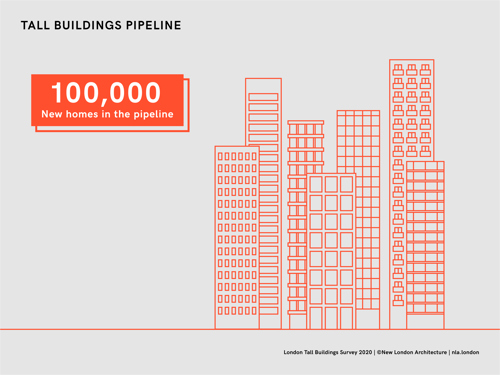
GL Hearn programme sponsor for NLA Tall Buildings Survey 2020
21 April 2020
New London Architecture (NLA) has announced the results of its annual London Tall Buildings Survey, now in its seventh year. The report, which GL Hearn is programme sponsor of, provides the only comprehensive analysis of tall buildings in the London. The survey includes all buildings of 20 storeys and over, which are proposed, in planning or under construction.
Record number of tall buildings added to London's skyline in the last year.
- A record 60 tall buildings were completed in 2019, up 140% from 2018, according to New London Architecture’s (NLA) Annual Tall Buildings Survey, published today.
- The total pipeline (buildings in pre-planning, planning and construction) currently stands at 525 tall buildings, a 3% drop from 541 in 2018
- But there was a slowdown in new tall building construction with starts at their lowest since 2015
- Outer London boroughs now account for 35% of the future tall building pipeline, a 6% increase on 2018
- Tall building ‘hotspots’ are Ealing, Greenwich and Haringey
- Tall buildings could provide 110,000 new homes, meeting a significant part of London’s housing requirements
The study published today (21 April 2020) shows that 60 tall buildings were completed in 2019 in London, the highest number on record. This represents a 140% increase from 25 tall building completions in 2018. Planning permissions continued to rise, by 7% in 2019, suggesting an increasing willingness of Planning Committees to approve tall building proposals.
Most tall building proposals are located within inner London. However, the survey shows that there has been a further shift towards outer zones; 13 of the 20 outer London boroughs now contain tall buildings at various stages of the process. There was a noticeable increase in outer London boroughs, with 6% more tall buildings in the pipeline compared to 2018.
Outer London boroughs now account for 35% of the future tall building pipeline, largely located in Opportunity Areas, as set out in the London Plan, and proposed public transport hubs. Newham continues to be the outer London borough with the largest number (37) though other 'hotspots' have emerged, such as Ealing (+8). Overall, the most significant increase in tall buildings, following Ealing, was in Barnet (+5), while the most notable decreases were in Tower Hamlets (-8) and Hackney (-6).
89% of all tall buildings in the pipeline, and 88% of all 2019 completions, are residential. These are estimated to provide over 110,000 new homes for London, just shy of two years’ supply of the housing need for London based on the new London Plan requirements of 65,000 homes per year.

Of the ones completed, 77% were located within a scheme with multiple use classes, with residential and retail, including food and drink, the most prevalent mixed-use combination, accounting for 22%. This more holistic approach can help unlock developments across London by opening the opportunity to forward-fund the commercial aspects of a building and attracting a wider range of buyers amid challenging conditions.
The study does show a decrease in the number of tall buildings that have commenced construction in 2019, the lowest number of new starts for tall buildings across London since 2015. This is consistent with the decline in planning applications submitted over the last couple of years, a result of the combination of the uncertain political backdrop in 2019, rising build costs as well as potential changes in policy.
- Share

